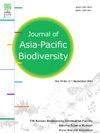Complete chloroplast genome of Physochlaina infundibularis Kuang (Hyoscyameae: Solanaceae): Comparative and phylogenetic analysis
IF 0.7
Q4 BIODIVERSITY CONSERVATION
引用次数: 0
Abstract
Physochlaina G. Don, a genus within Hyoscyameae, Solanaceae, holds significant medicinal value. It comprises approximately 10 species, primarily distributed in China, with chloroplast genomes reported for two species. In this study, the complete chloroplast genome of Physochlaina infundibularis was sequenced using the Illumina platform, revealing a size of 156,340 base pairs and containing 113 genes: 79 protein-coding genes, 30 transfer RNA-coding genes, and 4 ribosomal RNA-coding genes. The genome exhibited a guanine-cytosine (GC) content of 37.7%, consistent with other species in the genus, influencing codon preference toward A/U due to its lower GC content. Comparative analyses among P. infundibularis, Physochlaina orientalis, and Physochlaina physaloides highlighted high conservation within chloroplast coding regions relative to noncoding regions. Five genes showed notable nucleotide polymorphisms in protein-coding regions, suggesting potential as DNA barcodes. Phylogenetic investigations within Hyoscyameae and its sister groups resolved some taxonomic controversies. The newly sequenced chloroplast genome of P. infundibularis enriches our understanding of the genus and serves as a foundational resource for future phylogenetic research.
龙葵亚科龙葵全叶绿体基因组的比较与系统发育分析
龙葵属(Physochlaina G. Don)是龙葵科龙葵科的一个属,具有重要的药用价值。共有约10种,主要分布于中国,其中2种的叶绿体基因组已被报道。本研究利用Illumina平台对黄颡鱼(Physochlaina infunddibularis)叶绿体全基因组进行测序,发现基因组大小为156,340碱基对,包含113个基因,其中蛋白质编码基因79个,转移rna编码基因30个,核糖体rna编码基因4个。该基因组的鸟嘌呤-胞嘧啶(guine -cytosine, GC)含量为37.7%,与属内其他物种一致,由于其GC含量较低,影响了密码子对a /U的偏好。对比分析表明,与非编码区相比,黄颡鱼、东方鲷和绒泡鲷在叶绿体编码区具有较高的保守性。其中5个基因在蛋白质编码区表现出显著的核苷酸多态性,具有作为DNA条形码的潜力。对其姊妹类群的系统发育研究解决了一些分类学上的争议。新测序的infunddibularis叶绿体基因组丰富了我们对该属的认识,并为今后的系统发育研究提供了基础资源。
本文章由计算机程序翻译,如有差异,请以英文原文为准。
求助全文
约1分钟内获得全文
求助全文
来源期刊

Journal of Asia-Pacific Biodiversity
Agricultural and Biological Sciences-Insect Science
CiteScore
1.70
自引率
12.50%
发文量
94
审稿时长
27 days
期刊介绍:
The Journal of Asia-Pacific Biodiversity (previous title was Journal of Korean Nature) is an official journal of National Science Museum of Korea (NSMK) and Korea National Arboretum (KNA). The scope of journal is wide and multidisciplinary that publishes original research papers, review articles, as well as conceptual, technical and methodological papers on all aspects of biological diversity-its description, analysis and conservation, and its application by humankind. This wide and multidisciplinary journal aims to provide both scientists and practitioners in conservation theory, policy and management with comprehensive and applicable information. However, papers should not be submitted that deal with microorganisms, except in invited paper. Articles that are focused on the social and economical aspects of biodiversity will be normally not accepted.
 求助内容:
求助内容: 应助结果提醒方式:
应助结果提醒方式:


